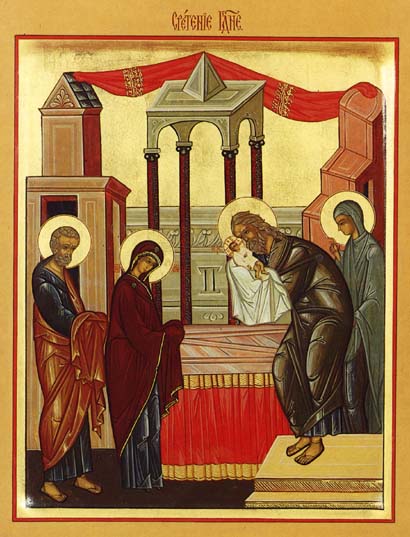Source: Orthodox England
In the Name of the Father and of the Son and of the Holy Spirit.
Today’s Feast has no fewer than four different names. Each name recalls a different aspect of this Feast. What are they?
First of all, today’s Feast is called the Presentation of Christ. This is because it commemorates the Presentation of Christ by His Mother in the Temple at Jerusalem exactly forty days after His Birth. As we can see from the icon of the Feast, Christ was brought to the Temple by His mother and accompanied by His guardian Joseph, who holds the customary sacrifice of two turtle doves. In the Temple Christ was carried in the arms of the Righteous Simeon and watched over by the Prophetess Anna. This Feast is yet more proof that the Son of God truly became man. Today an infant, not a spirit or an angel, is brought to the Temple.
This meeting between the Righteous Simeon and Anna and the Saviour is why this Feast has another, very common name: ‘The Meeting of the Lord’. According to age-old tradition, Simeon was one of those Seventy translators who in the third century before Christ had translated the Scriptures of the Old Testament into Greek. Coming to the words in the seventh chapter of Isaiah the Prophet, he had been awestruck by the affirmation that a Virgin would give birth. He had been told by the Holy Spirit that he would live until he saw these words fulfilled. At today’s Feast which is the fulfillment of these words, the aged Simeon utters the words: ‘Now lettest Thou Thy servant depart in peace according to Thy words, for mine eyes have seen Thy salvation, which Thou hast prepared before the face of all people, a light to lighten the Gentiles and the glory of Thy people Israel’. Soon after uttering these words, he reposed, as did the Righteous Anna, who had also been waiting to see the fulfillment of the promise of the Holy Spirit that she too would see the Messiah in great old age. The Prayer of St Simeon is read at every Vespers service in the Church Year, but at Vespers yesterday, and again tonight, before tomorrow’s Feast of St Simeon and St Anna, it is sung.

According to the Old Testament, the Jews were commanded to present their male children at the Temple in Jerusalem forty days after their Birth. This was to give thanks to God and pray for the purification of the mother and health of the child, for it was considered that after the vital forty-day period it was almost certain that all mortal danger was passed. This is why this Feast has yet another name: ‘The Purification of the Virgin’. The Christ-Child is only forty days old, the salvation of the world is dependent on His Mother. This is why although this Feast is a Feast in honour of Our Lord, the Church is yet in blue, for we also give great honour today to the Mother of God. Indeed, this Feast is the Feast of all mothers.
In our New Testament times, we have the custom of ‘churching’, which is similar to this rite of purification of the mother, which was carried out in the Old Testament, but there are also important differences. First of all, since the Coming of Christ, all children, not only boys, are to be presented in church at the age of forty days. However today, they are to be presented for baptism and chrismation and so made ready for holy communion. Secondly, the Church also appoints prayer to be said over the mother at this critical time. These prayers are firstly in thanksgiving for the physical safety of the mother, but also they are said for the spiritual safety of the mother, in order to ward off what is now called ‘post-natal depression’.
The Presentation, the Meeting and the Purification are then all names given to today’s Feast, but there is yet a fourth name – Candlemas. This name was given to this Feast in memory of the Roman custom of lighting candles at it, which recalls the lights in the Temple at Jerusalem. The custom spread from Rome even to western parts of Russia and in the Russian service-books there is a prayer for the blessing of candles on this day. In this country, Candlemas is connected with many popular sayings concerning weatherlore, witnessing to the popularity of Candlemas in olden times. One such saying for example is: ‘If Candlemas be fair and bright, winter shall have another flight’. This means that if today’s weather is good, we shall have more cold and wintry weather before the Spring.
But what does this Feast mean for us today?
Since it is exactly forty days since Christmas, it is time for us to think about the last forty days and ask ourselves some questions:
What today can we present to the Temple of Christ, the Church? In what condition do we present our souls to Christ? What sacrifices have we made in the last forty days? Have we begun cultivating a new virtue? Have we attempted to give up an old vice? Have we been to confession? Have we taken communion? Have we kept the Wednesday and Friday fasts? Have we read our prayers? Have we set a Christian example to our neighbours? Have we thanked God for all that we have received? What has changed in our way of life since the Birth of Christ forty days ago? What progress has been made?
Whatever our answers to these questions, on this, the Feast of the Meeting of Christ, one thing is certain: If we are not spiritually prepared to meet Christ, then we shall never meet Him.
Amen.
















